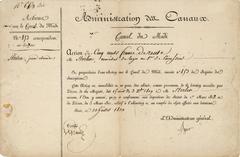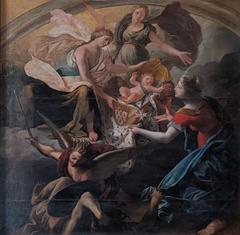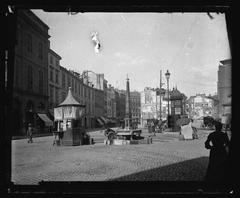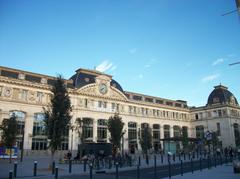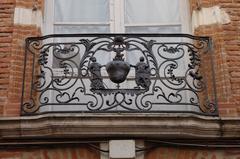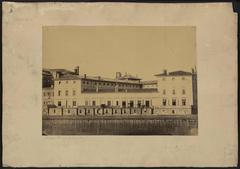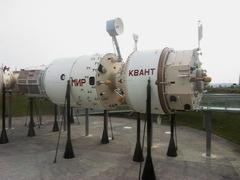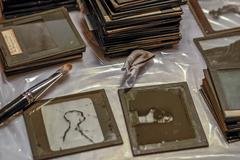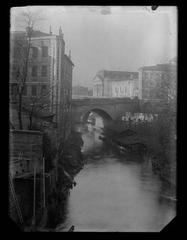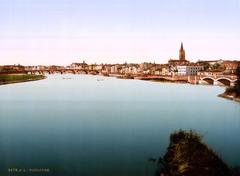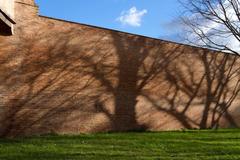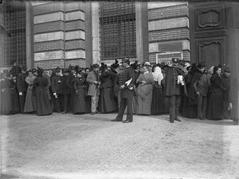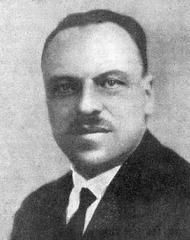Rangueil Toulouse Visiting Hours, Tickets, and Historical Sites Guide
Date: 04/07/2025
Introduction: The Historical and Modern Significance of Rangueil, Toulouse
Located in the southeast of Toulouse, the Rangueil district is a vibrant blend of academic achievement, scientific innovation, and cultural life. While Toulouse’s origins stretch back to Roman times and the Volcae Tectosages tribe, Rangueil’s identity is more contemporary, shaped by the city’s mid-20th-century expansion. Set against the scenic backdrop of the Coteaux de Pech David and adjacent to the UNESCO-listed Canal du Midi, Rangueil provides both natural beauty and access to Toulouse’s dynamic urban fabric (World City History; Trek Zone).
Rangueil’s transformation into a major educational and scientific hub began in the 1960s with the establishment of the University of Toulouse III – Paul Sabatier and other renowned institutions like INSA Toulouse. Strategic governmental policies aimed at decentralizing research and education solidified Rangueil’s reputation as a center for innovation (GeoTolosa 2025; Face Grand Toulouse). The district is also home to the Hôpital Rangueil, a leading medical facility since 1975 (CHU Toulouse).
Well-integrated infrastructure—including the Toulouse Metro Line B, extensive cycling routes, and accessible public transport—supports Rangueil’s lively academic and community life (Metro Toulouse; Toulouse Métropole). The area’s cultural assets (such as the Jules-Julien Theater), green spaces, and proximity to historical sites like the Basilique Saint-Sernin make it a microcosm of Toulouse’s broader heritage and progress (Wikipedia; Basilique Saint-Sernin Official Site).
This comprehensive guide covers Rangueil’s history, key attractions, visitor information (including hours and tickets), accessibility, transport, and nearby sites—offering everything you need for an enriching visit.
Table of Contents
- Early Origins and Geographic Context
- Urbanization and the Rise of Science and Education
- Healthcare Milestones in Rangueil
- Transport and Infrastructure
- Scientific and Cultural Highlights
- Visitor Information: Hours, Tickets, and Travel Tips
- Key Historical Milestones and Recent Developments
- Major Attractions and Landmarks
- FAQ: Visiting Rangueil
- The Basilique Saint-Sernin: Hours, Tickets, and Visitor Details
- Summary, Travel Tips, and Updates
- References and Official Links
Early Origins and Geographic Context
Rangueil evolved as Toulouse expanded beyond its medieval confines. Its setting on the Coteaux de Pech David offers panoramic views of the Garonne River and proximity to the historic Canal du Midi—both influential in the city’s development (World City History; Trek Zone).
Urbanization and the Rise of Science and Education
The district’s significant growth began in the 1960s and 1970s, as Toulouse became a center of science, technology, and higher education. The University of Toulouse III – Paul Sabatier opened its main campus in Rangueil in 1969, followed by engineering schools (notably INSA Toulouse) and research institutes. This concentration created a thriving academic environment, attracting students and professionals from across France and internationally (GeoTolosa 2025; Face Grand Toulouse).
Healthcare Milestones in Rangueil
Hôpital Rangueil, inaugurated in 1975, established the district as a center for medical care and research. As part of the Toulouse University Hospital (CHU), it consolidated adult medical and surgical specialties and continues to modernize its facilities, reinforcing Rangueil’s healthcare leadership (CHU Toulouse).
Transport and Infrastructure
Rangueil’s urban integration has been strengthened by major transport projects. The Toulouse Metro Line B, with Rangueil station, connects the area to the city center and other districts. Artistic installations at the station reflect the area’s creative spirit (Metro Toulouse). The district is also served by a comprehensive public transport network, cycling paths, and access to the A620 ring road, though modernization has led to periodic closures (Toulouse Métropole; Le Journal Toulousain).
Scientific and Cultural Highlights
Rangueil balances its scientific landscape with cultural assets like the Jules-Julien Theater, student-led initiatives, and ample green spaces, especially the Coteaux de Pech David. The district’s “city within a city” identity is shaped by its mix of residential zones, campuses, and healthcare facilities—fostering a youthful, multicultural community (Wikipedia).
Visitor Information: Hours, Tickets, and Travel Tips
Visiting Hours and Tickets
- University of Toulouse III – Paul Sabatier: Campus grounds open during daylight hours; specific building access/events may require registration or tickets.
- Hôpital Rangueil: Visiting hours vary by department; check CHU Toulouse for details.
- Jules-Julien Theater: Performances and cultural events; tickets available online or at venue.
- Metro Rangueil Station: Open daily (approx. 5:30 AM–midnight). Tickets sold at stations or via public transport app.
Accessibility and Travel Tips
- Transport: Metro Line B, buses, and cycling routes connect Rangueil with Toulouse.
- Accessibility: Metro stations and key public buildings are wheelchair accessible.
- Driving: A620 ring road and Rangueil interchange offer car access; watch for traffic updates.
Special Events and Guided Tours
- Public lectures, conferences, and cultural events are frequently hosted by the university and research centers.
- Guided tours of green spaces and the Canal du Midi are available via local tourism offices.
Key Historical Milestones and Recent Developments
- 1969: University of Toulouse III – Paul Sabatier campus opens (GeoTolosa 2025).
- 1975: Hôpital Rangueil begins operations (CHU Toulouse).
- 2007: Metro Line B launches with Rangueil station (Metro Toulouse).
- 2020s: Expansion of hospital, new cycling infrastructure, bus lines (Toulouse Métropole).
Major Attractions and Landmarks
- University of Toulouse III – Paul Sabatier: Science and technology campus.
- Hôpital Rangueil: Medical research and care (CHU Toulouse).
- Metro Rangueil Station: Gateway to the district (Metro Toulouse).
- Coteaux de Pech David: Outdoor activities and views (Trek Zone).
- Canal du Midi: Walking and cycling along a UNESCO World Heritage site.
FAQ: Visiting Rangueil
Q: When is the best time to visit Rangueil?
A: Spring and autumn offer ideal weather for outdoor activities.
Q: Are guided tours offered?
A: Seasonal tours are available via local tourism offices.
Q: Is Rangueil accessible for visitors with disabilities?
A: Yes, key attractions and public transport are accessible.
Q: Do I need tickets for university or research centers?
A: Campus grounds are open; special events/buildings may require tickets.
Q: How do I reach Rangueil from the city center?
A: Metro Line B to Rangueil station is the most direct route.
The Basilique Saint-Sernin: Hours, Tickets & Visitor Details
About the Basilica
Basilique Saint-Sernin, a UNESCO World Heritage site near Rangueil, is the largest Romanesque church in Europe, renowned for its architecture, crypt, and bell tower (Basilique Saint-Sernin Official Site).
Opening Hours
- Monday–Saturday: 10:00 AM–6:00 PM
- Sunday: 1:00 PM–6:00 PM
- Closed: January 1, May 1, December 25
Tickets
- General admission: Free
- Guided tours/crypt access: €5–€10; groups (10+) should reserve in advance.
Getting There from Rangueil
- Metro: Line B to Jean Jaurès, transfer to Line A, stop at Capitole or nearby.
- Bus: Lines 23/34 connect Rangueil with the city center.
- Cycling: About 30 minutes via city cycle paths.
- Car: Paid parking lots within a 10-minute walk.
Dining and Accommodation
- Nearby options include traditional brasseries (e.g., Le Bibent), the Victor Hugo Market, and hotels in the Capitole and Les Chalets neighborhoods.
Special Events
- The basilica hosts concerts, guided tours, and annual religious celebrations (notably November 29th for Saint Saturnin).
Visitor Tips
- Arrive early to avoid crowds.
- Photography (no flash) is allowed; tripods require approval.
- Most areas are wheelchair accessible; the crypt has limited access.
Summary and Visitor Tips
Rangueil is a unique district where history, science, and culture intersect. Its strategic location and robust infrastructure make it an ideal base for exploring both the academic and heritage sites of Toulouse. With easy access to the Canal du Midi, Basilique Saint-Sernin, and the city center, Rangueil appeals to visitors interested in innovation, culture, and outdoor activities. For up-to-date guides and events, consider using the Audiala app (GeoTolosa 2025).
References and Official Links
- Face Grand Toulouse
- GeoTolosa 2025
- CHU Toulouse
- Toulouse Métropole
- Metro Toulouse
- World City History
- Wikipedia
- Basilique Saint-Sernin Official Site
- Trek Zone

